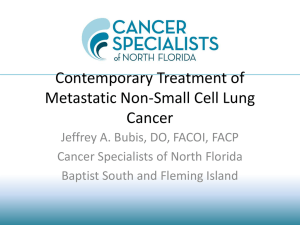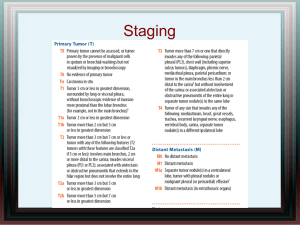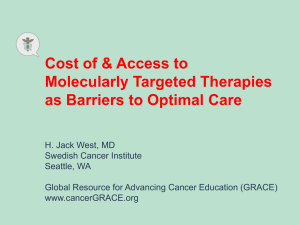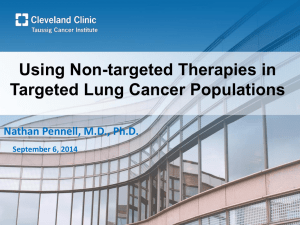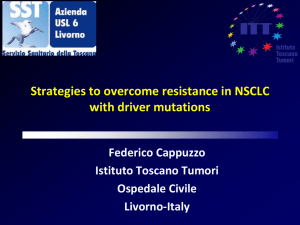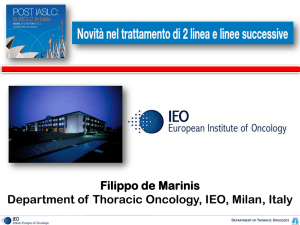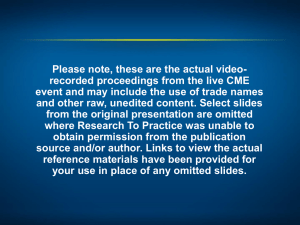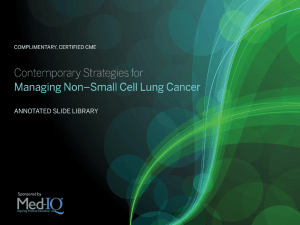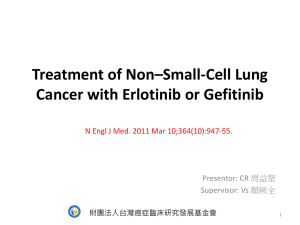Diapositiva 1
advertisement
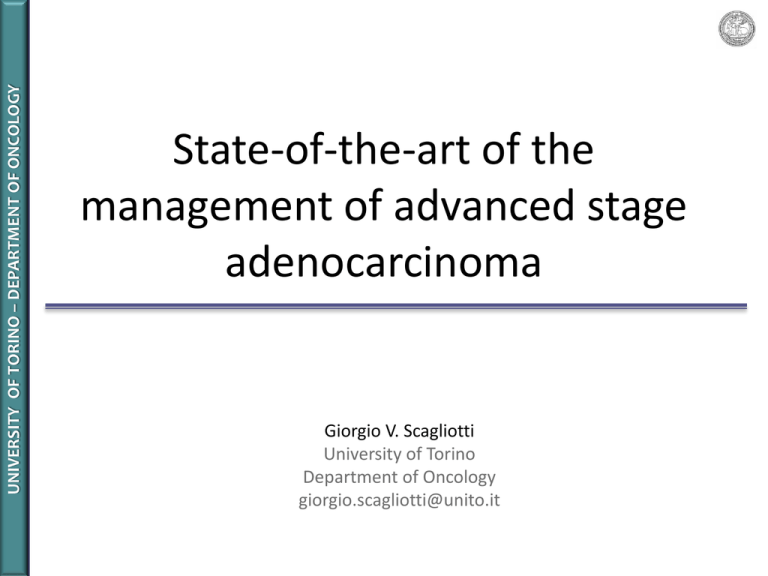
ONCOLOGY OFONCOLOGY TORINO––DEPARTMENT UNIVERSITY UNIVERSITYOFOFTORINO DEPARTMENTOF State-of-the-art of the management of advanced stage adenocarcinoma Giorgio V. Scagliotti University of Torino Department of Oncology giorgio.scagliotti@unito.it UNIVERSITY OF TORINO – DEPARTMENT OF ONCOLOGY First-line therapy for metastatic NSCLC in 2012 UNIVERSITY OF TORINO – DEPARTMENT OF ONCOLOGY First-line therapy for metastatic NSCLC in 2012 UNIVERSITY OF TORINO – DEPARTMENT OF ONCOLOGY Disease segmentation based on oncogenic events From an organ-based disease to a molecular classifications of rare diseases « Druggable » genomic alterations 4 UNIVERSITY OF TORINO – DEPARTMENT OF ONCOLOGY 2002-2012 – Changes in the therapeutic landscape of stage IV lung cancer HER2 EGFR mutants ALK ROS/RET b-raf K-ras K-ras Adeno LCC/NOS SCC SCLC UNIVERSITY OF TORINO – DEPARTMENT OF ONCOLOGY Chipping away at the lung cancer genome Lung Adenocarcinoma Squamous Cell Carcinoma of the lung Pao W. Nat. Med. 2012 ; Sos M. and Thomas R. Oncogene 2012 UNIVERSITY OF TORINO – DEPARTMENT OF ONCOLOGY EGFR-TKIs and EGFR Mutation -Directed Front - Line Studies Study Entry Criteria HR for PFS (EGFR mut +) HR for OS (EGFR mut +) IPASS Mok NEJM 2009 Asiatic, never- & light – smokers, adenocarcinoma (EGFR mut + 59.7%) 0.48 (0.36-0.66) 0.91 * (0.76-1.10) *overall population First – SIGNAL Proc. IASLC 2009 Adenocarcinoma, Neversmokers (EGFR mut + 44%) 0.61 (0.30-1.22) 0.82 (0.35-1.92) NEJ002 NEJM 2010 Proc. ASCO 2011 EGFR Mutation + (all) 0.35 (0.25-0.50) 0.887 (0.634-1.241) WJTOG3405 Lancet Onc. 2010 EGFR Mutation + (all) 0.520 (0.378-0.715) 1.185 (0.767-1.829) EURTAC (EU) EGFR Mutation + (all) 0.42 (0.27-0.64) ? OPTIMAL (China) EGFR Mutation + (all) 0.16 (0.10-0.26) 1.04 (0.69–1.58) UNIVERSITY OF TORINO – DEPARTMENT OF ONCOLOGY Clinical characteristics do not completely predict EGFR mutation status Spanish Lung Cancer Group trial in advanced NSCLC patients with EGFR mutations (n=350)1 Patients 100% Female Never smoker 80% 60% 40% 20% Adenocarcinoma Significant segment of EGFR M+ population fall outside typical subgroups 30 Male 26 Former smoker 0% Gender BAC, bronchioloalveolar carcinoma Smoking status 9 Non-adeno / BAC Histology 1Rosell et al 2009 UNIVERSITY OF TORINO – DEPARTMENT OF ONCOLOGY EGFR Targeted Therapeutics in NSCLC Matuzumab Cetuximab Panitumumab Necitumumab (IMC-11F8) K EGFR K TKI EGFR Gefitinib Erlotinib Lapatinib Afatinib Dacomitinib UNIVERSITY OF TORINO – DEPARTMENT OF ONCOLOGY EGFR-TKIs and EGFR Mutation -Directed Front - Line Studies Study Entry Criteria HR for PFS (EGFR mut +) HR for OS (EGFR mut +) IPASS Mok NEJM 2009 Asiatic, never- & light – smokers, adenocarcinoma (EGFR mut + 59.7%) 0.48 (0.36-0.66) 0.91 * (0.76-1.10) *overall population First – SIGNAL Proc. IASLC 2009 Adenocarcinoma, Neversmokers (EGFR mut + 44%) 0.61 (0.30-1.22) 0.82 (0.35-1.92) NEJ002 NEJM 2010 Proc. ASCO 2011 EGFR Mutation + (all) 0.35 (0.25-0.50) 0.887 (0.634-1.241) WJTOG3405 Lancet Onc. 2010 EGFR Mutation + (all) 0.520 (0.378-0.715) 1.185 (0.767-1.829) EURTAC (EU) EGFR Mutation + (all) 0.42 (0.27-0.64) ? OPTIMAL (China) EGFR Mutation + (all) 0.16 (0.10-0.26) 1.04 (0.69–1.58) LUX-LUNG 3 EGFR Mutation + (all) 0.58 (0.43–0.78) ? UNIVERSITY OF TORINO – DEPARTMENT OF ONCOLOGY FLEX : HRs for death in pre-specified subgroup analysis of the ITT population Pirker R. et al. Lancet 2009; 373:1525-31 UNIVERSITY OF TORINO – DEPARTMENT OF ONCOLOGY Clinical Profile of ALK-positive NSCLC • Gene fusions involving the ALK gene within chromosome 2 have been identified in 0.6‒11.6% of NSCLC tumors1,2 – Incidence rates are influenced by sample size, screening methods and enrichment prior to pre-selection • ALK is associated with adenocarcinoma histology – Incidence of 2.4–5.6%3–5 – In squamous cell patients incidence of ALK <1%1 • Trend for ALK patients to be non/light smokers2–4 • ALK mutations appear to occur in the absence of EGFR/KRAS mutations2,3,7 • Possible correlation between signet ring carcinoma and ALK status3 1Boland et al. Human Pathol 2009;40:1152–8; 2Zhang et al. Mol Cancer 2010;9:188 et al. Clin Cancer Res 2009;15:5216–23; 4Wong et al. Cancer 2009;115:1723–33 5Takahashi et al. Ann Surg Oncol 2010;17:889–97 6Horn and Pao J Clin Oncol 2009;27:4232‒35; 7Shaw et al. J Clin Oncol 2009;27:4247–53 3Rodig UNIVERSITY OF TORINO – DEPARTMENT OF ONCOLOGY UNIVERSITY OF TORINO – DEPARTMENT OF ONCOLOGY Erlotinib in EGFR mutant NSCLC Vemurafenib in BRAF mutant melanomas Crizotinib in ALK rearranged NSCLC UNIVERSITY OF TORINO – DEPARTMENT OF ONCOLOGY ROS1 Rearrangement in NSCLC • 18/1073 tumors (1.7%) rearranged by FISH. • ROS1 re-arranged pts significantly younger and more likely to be never smokers (p <0.001) • All adenocarcinoma, higher grade • ROS1+ vs. ROS1 – no difference in survival • Sensitive to crizotinib UNIVERSITY OF TORINO – DEPARTMENT OF ONCOLOGY RET gene fusion in lung adenocarcinoma • 11,294,741-bp pericentric inversion on chromosome 10 generating a new gene fusion joining exons 1-15 of KIF5B to exons 12-20 of RET • Mutually exclusive with EGFR, HER2, KRAS, BRAF mutations and with ALK or ROS1 translocation • Exclusively identified in adenocarcinomas, never or light smokers Lipson et al. Nature Med. 2012 UNIVERSITY OF TORINO – DEPARTMENT OF ONCOLOGY Kinase oncogene dependence and principles of drug resistance Wagle N. et al. J. Clin. Oncol. 2011; 29:3085 UNIVERSITY OF TORINO – DEPARTMENT OF ONCOLOGY Genotypic Evolution of Lung Cancer Acquiring Resistance to EGFR and ALK Inhibitors ALK ALK EGFR KRAS ALK ALK ALK Sequist L. et al. Sci. Transl. Med. 2011; 3 (75) 75ra26 Doebele R. et al. Proc. ASCO 2012 UNIVERSITY OF TORINO – DEPARTMENT OF ONCOLOGY How to improve results in EGFR mutants ? EGFR TKI + HD 2nd-gen EGFR TKI EGFR TKI + BCL-2i Chemo-naïve advanced NSCLC EGFR TKI + IGF-1Ri EGFR mutant EGFR TKI + METi EGFR TKI + HCQ EGFR TKI (diff dosing schedules) EGFR TKI + chemo Potent 2nd-gen EGFR TKI EGFR mutant NSCLC with acquired resistance* 2nd-gen EGFR TKI + cetuximab Chemo EGFR TKI 2nd-gen EGFR TKI + METi UNIVERSITY OF TORINO – DEPARTMENT OF ONCOLOGY K-ras mutation & NSCLC • Is k-ras mutation prognostic or predictive ? • Is there any evidence for excluding k-ras mutants from receiving chemo? K-ras K-ras K-ras mutation not predictive or prognostic in resected early stage NSCLC treated with adjuvant chemotherapy (Shepherd F. et al. Proc. ASCO 2012) Meta-Analysis of 881 Cases - Stages I-IV - RR of 2.35 (1.6-3.2) at 2 years k-ras mutation may be associated with shortened survival but need to be confirmed in well designed multivariate analyses addjusted for known prognostic factors (Huncharek M et al., Carcinogenesis 1999) K-RAS mutational status does not predict benefit from the anti-EGFR monoclonal antibody cetuximab (O’ Byrne Lancet Oncology 2011) UNIVERSITY OF TORINO – DEPARTMENT OF ONCOLOGY First-line therapy for metastatic NSCLC in 2012 UNIVERSITY OF TORINO – DEPARTMENT OF ONCOLOGY Cis/Pem vs. Cis/Gem in Advanced NSCLC Scagliotti GV et al. J. Clin. Oncol 2008; 26:3543 p<0.0001 Adenocarcinoma Relative expre. levels Relative expre. levels UNIVERSITY OF TORINO – DEPARTMENT OF ONCOLOGY Squamous cell carcinoma of the lung compared with other histotypes shows higher messenger RNA and protein levels for thymidylate synthase P<0.001 Squamous P<0.001 Ceppi et al. Cancer 2006 UNIVERSITY OF TORINO – DEPARTMENT OF ONCOLOGY Summary of the Effect of Pemetrexed in Patients with Advanced NSCLC by ALK Status • Reports from three small, retrospective analyses suggest pemetrexed given as a single agent or in combination with chemotherapy may be effective in ALK-positive NSCLC1–3 Report Camidge et al2 Lee et al3 Altavilla et al1 Treatment Pemetrexed single agent or combination therapy, any line Second-line or later single-agent pemetrexed Pemtrexed + cisplatin TTP, time to progression Study populations and comparator populations N ORR (%) Time to event, months (95% CI) ALK-positive NSCLC 19 42 PFS, 9.0 (95% CI: 3–12) ALK/EGFR/KRAS-triple negative NSCLC 37 14 PFS, 4.0 (95% CI: 3–5) ALK-positive NSCLC 15 47 TTP, 9.2 (95% CI: 4.7–13.7) EGFR wild-type NSCLC 37 ALK-positive NSCLC, adenocarcinoma 8 25 TTP, 9.0 ALK-negative NSCLC 32 – TTP, 6.2 TTP, 2.9 1. Altavilla G, Santarpia M, Arrigo C, et al. J Clin Oncol 2010;28 (Abstract 7610) 2. Camidge DR, Kono SA, Lu X, et al. J Thorac Oncol 2011;6:774–780 3. Lee JO, Kim TM, Lee SH, et al. J Thorac Oncol 2011;6:1474–1480 TS Expression N Median ALK+ Patients 63 2.02 1.60-2.11 0.55-19.44 3.32 3.15-3.45 0.36-53.51 ALK- Patients 1698 95% CI Range p Value <0.0001 60 20 50 15 10 All ALK-neg TS2 UNIVERSITY OF TORINO – DEPARTMENT OF ONCOLOGY TS Expression in ALK+ versus ALK- NSCLC 40 30 20 5 10 0 0 TS in patients with ALK+ cancers TS in patients with ALK- cancers Gandara D. et al. Proc. ASCO 2012 UNIVERSITY OF TORINO – DEPARTMENT OF ONCOLOGY Agents Targeting the VEGF Pathway Anti-VEGF Antibodies Soluble VEGFRs (bevacizumab) (VEGF-Trap) VEGF Anti-VEGFR Antibodies (IMC-1121b) P P P P P P VEGFR-1 P P VEGFR-2 Endothelial Cell Small-molecule VEGFR inhibitors: • • • • • Vatalanib (PTK 787) Sunitinib (SU11248) Sorafenib (Bay 43-9006) Vandetanib (ZD6474) AZD 2171 Podar K, Anderson KC. Blood 2005;105:1383–1395 UNIVERSITY OF TORINO – DEPARTMENT OF ONCOLOGY Targeting angiogenesis in NSCLC the rationale Need to improve outcomes for patients with NSCLC: late diagnosis and poor prognosis1,2 Angiogenic factors, including growth factor overexpression, are found in more than 46% of NSCLC tumours3,4 Why inhibit angiogenesis in NSCLC? The growth of new blood vessels and the presence of angiogenic growth factors are associated with poor prognosis in NSCLC5 1Yang Anti-angiogenic therapy in NSCLC may slow or reverse tumour growth and prevent metastases5 P, et al. Chest 2005; 128:452–462; 2Cancer Research UK 2010 3Shou Y, et al. Br J Cancer 2001:85:1706–1712; 4O’Byrne KJ, et al. Br J Cancer 2000;82:1427–1432; 5Bremnes RM, et al. Lung Cancer 2006;51:143–158. UNIVERSITY OF TORINO – DEPARTMENT OF ONCOLOGY Phase III studies of VEGF antibody inhibition in NSCLC Trial Treatment line Treatment arms Primary endpoint Trial outcome ECOG 45991 First line Paclitaxel/carboplatin + bevacizumab OS 12.3 months* Positive Paclitaxel/carboplatin 10.3 months Cisplatin/gemcitabine + bevacizumab PFS High dose: 6.5 months* Low dose: 6.7 months* Cisplatin/gemcitabine + placebo 6.1 months Bevacizumab + erlotinib OS 9.3 months Erlotinib + placebo 9.2 months Bevacizumab + erlotinib PFS 4.8 months* Bevacizumab + placebo 3.7 months AVAiL2 BETA3 ATLAS4,5 First line Second line First line maintenance Positive for primary endpoint Negative Positive for primary endpoint *Significantly different from comparator. 1Sandler A, et al. N Engl J Med 2006;355:2542–550; 2Reck M, et al. J Clin Oncol 2009;27:1227–1234; 3Hainsworth J, et al. J Thor Oncol 2008;3:S302; 4Miller VA, et al. J Clin Oncol 2009;27(suppl 1):Abstract LBA8002 and presentation; 5Kabbinavar FF, et al. J Clin Oncol 2010;28:7526. UNIVERSITY OF TORINO – DEPARTMENT OF ONCOLOGY ECOG 4599: Survival by Histology Subtype Baseline Characteristics PC (n = 444) PCB (n = 434) Median N Months Median N Months 878 444 10.3 434 - Adenocarcinoma 602 302 10.3 - Large Cell 48 30 8.7 - Squamous 3 2 - BAC 23 - NSCLC,NOS - Other All patients Total N Hazard Ratio 95% CI 12.3 0.80 0.69-0.93 300 14.2 0.69 0.58-0.83 18 10.0 1.15 0.60-2.24 12.3 1 22.4 0.00 0.00- 11 17.7 12 10.0 1.48 0.57-3.69 165 86 10.0 79 9.5 1.16 0.84-1.61 34 11 12.6 23 8.4 0.92 0.43-1.98 Histologic type Sandler A. et al. J Thorac Oncol. 2008;3(11 Suppl 4): Abstract 133. UNIVERSITY OF TORINO – DEPARTMENT OF ONCOLOGY Progress in the treatment of metastatic lung cancer Pao W. et al. Nat. Rev. Cancer 2010; 10;760 UNIVERSITY OF TORINO – DEPARTMENT OF ONCOLOGY Bevacizumab biomarker trial in NSCLC ABIGAIL (BO21015): phase II biomarker trial Previously untreated stage IIIB/IV non-squamous NSCLC (n=300) Bevacizumab 7.5mg/kg + carboplatin/gemcitabine or carboplatin/paclitaxel Bevacizumab q3w until progression PD Bevacizumab 15mg/kg + carboplatin/gemcitabine or carboplatin/paclitaxel Bevacizumab q3w until progression PD • Primary endpoint: correlation of biomarkers with response rate • Conclusion – After adjustment for multiple testing, none of the candidate biomarkers correlated with overall response rate according to baseline plasma level Mok, et al. ESMO 2011 UNIVERSITY OF TORINO – DEPARTMENT OF ONCOLOGY Targeting alternative pathways to VEGF: FGF and PDGFR FGF, PDGFR & others • After blockade of VEGF pathway, there is compensatory up-regulation of FGF, PDGFR, EGFR, others • Additional blockade of FGF, PDGFR suppresses angiogenesis FGF(R)=fibroblast growth factor (receptor); PDGF(R)=platelet-derived growth factor (receptor); VEGF(R)=vascular growth factor (receptor). Casanovas O, et al. Cancer Cell 2005;8:299–309. UNIVERSITY OF TORINO – DEPARTMENT OF ONCOLOGY Many multi-targeted anti-angiogenic agents are already failed Phase III development in NSCLC Agent Description Target NSCLC Sunitinib1 Small-molecule TKI VEGFR-1,-2, 3; PDGFRβ; c-kit; Flt-3 Phase III (terminated) Sorafenib2 Small-molecule TKI b-Raf; VEGFR-2, -3; PDGFRβ; Flt-3; c-kit Phase III (terminated) Cediranib3 Small-molecule TKI VEGFR-1, -2, -3; PDGFR; FGFR-1; ckit Phase III (terminated) Vandetanib4 Small-molecule TKI VEGFR-2, -3; EGFR Phase III (terminated) Aflibercept5 VEGF-trap Fusion protein that binds to binds to VEGFR-1 and VEGFR-2 Phase III (terminated) Vadimezan (ASA 404)6 Vascular disrupting agent Motesanib7 Small-molecule TKI VEGFR-1, -2, -3; PDFGR; c-kit BIBF 11208 Small-molecule TKI VEGFR-1, -2, -3; PDGFRα, -β; FGFRPhase III (terminated) 1,-2, -3 1Christensen Phase III (terminated) Phase III (terminated) JG, et al. Ann Oncol 2007;Suppl 10; 2Wilhelm SM, et al. Cancer Res 2004;64:7099–7109; 3Wedge SR, et al. Cancer Res 2005;65:4389–4400; 4Ryan AJ, et al. Br J Cancer 2005;92(Suppl 1):S6–S13; 5Hsu JY, Wakelee HA. BioDrugs 2009;23:289–304; 6Baguley BC, et al. Future Oncol 2010;6:1537–1543; 7Rosen LS, et al. J Clin Oncol 2007;25:2369–2376; 8Hilberg F, et al. Cancer Res 2008;68:4774–4782. UNIVERSITY OF TORINO – DEPARTMENT OF ONCOLOGY Summary • EGFR Mut+ lung cancer should be treated with and EGFR TKI and ALK translocated tumors with crizotinib. • Therapeutic choices based on histology are the current standard of care for the majority of our patients • In non-squamous histology cisplatin plus pemetrexed or platinum-doublet chemotherapy plus bevacizumab are effective treatment choices. The efficacy/toxicity ratio favors cisplatin and pemetrexed. • The definition of homogeneous genetic subgroups of tumours and the search for individualised approaches is the way to substantially increase survival expectancy in this disease 1. NCCN NSCLC guidelines 2012
